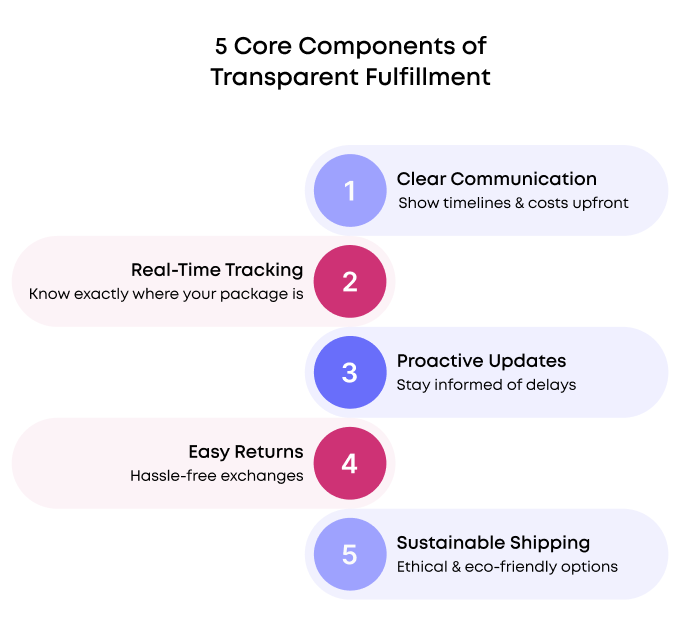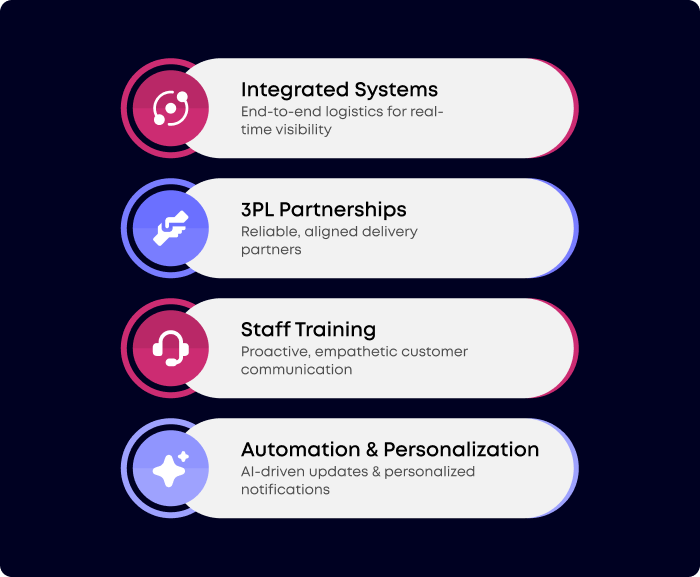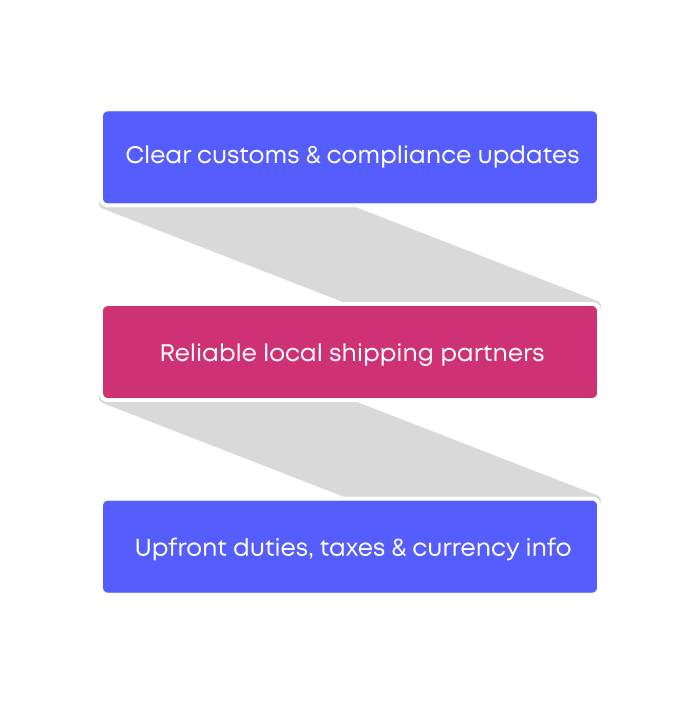Introduction
In the digital era, customer loyalty is no longer driven solely by product quality or price. Today’s consumers expect a seamless experience across every stage of the buying journey, with fulfillment serving as a crucial touchpoint. How a business manages order processing, shipping, and returns directly influences consumer perception and long-term trust.
Transparent fulfillment, where customers have visibility into order status, shipping timelines, and delivery processes is increasingly recognized as a key differentiator. It reduces uncertainty, enhances customer satisfaction, and fosters repeat business. By understanding the mechanics and benefits of transparent fulfillment, businesses can cultivate deeper, more sustainable customer relationships.
Why Transparent Fulfillment Matters

Customer Expectations
Consumers today demand more than just delivery—they want certainty and control. Research indicates that:
- 98% of customers expect the ability to track their orders in real-time
According to a report by ShipBob, over 90% of customers expect the ability to monitor their orders throughout every step of the shipping process. 73% of customers expect real-time order tracking across all touchpoints, and more than 98% of shoppers say that the order delivery process impacts their brand loyalty. - 83% would switch to a competitor if a company fails to communicate effectively during delivery
Capgemini's research indicates that 55% of consumers will switch to a competing retailer or brand if it offers a faster delivery service. - 92% of shoppers are more likely to repurchase from retailers offering transparent, hassle-free returns
According to ShipBob, 92% of shoppers say they will buy again if the returns process was easy.
These statistics underscore a simple truth: fulfillment transparency is now integral to trust, which in turn drives loyalty.
Building Predictability
When a customer orders a product, uncertainty generates anxiety. Questions like “When will it arrive?” or “What if it gets lost?” can undermine satisfaction. Transparent fulfillment addresses this by providing clear, accurate, and timely information, creating a predictable experience.
Core Components of Transparent Fulfillment

1. Clear Communication of Shipping Details
Transparency begins before purchase. Customers must understand:
- Delivery timelines: Avoid vague claims like “fast shipping.” Provide specific windows such as “3–5 business days.”
- Shipping costs: Hidden fees at checkout can erode trust.
- Return policies: Clearly define the return process, deadlines, and potential costs.
Best Practice: Display shipping and return details prominently on product pages. Retailers like Apple and Amazon excel at this by offering accurate delivery dates during checkout.
2. Real-Time Order Tracking
Static tracking numbers are no longer sufficient. Customers value dynamic, end-to-end tracking, which can include:
- Status updates from warehouse processing to courier pickup.
- Interactive tracking maps showing the package location.
- Automated notifications for each milestone: shipped, in transit, out for delivery, delivered.
Impact: Real-time tracking reduces anxiety and decreases support inquiries, fostering a sense of control and reliability. Salesforce reports that 74% of customers say real-time updates improve loyalty.
3. Proactive Communication
Even the most robust logistics systems encounter delays. Transparent fulfillment relies on proactive notifications, keeping customers informed rather than reactive explanations.
- Example: If weather delays shipping, a timely message can reassure:
“Your order will arrive one day later due to local weather conditions. We are monitoring it closely and will provide updates.”
Honest communication, even when the news is unfavorable, reinforces trust and credibility.
4. Transparent Returns and Exchanges
A seamless returns process is vital for customer confidence:
- Clearly state return windows and conditions.
- Provide return tracking and confirmation notifications.
- Offer multiple return options, including courier pickup, drop-off points, or in-store returns.
Deloitte reports that 67% of customers who experience smooth returns become repeat buyers (Deloitte, 2022). Transparency in this process ensures that the fulfillment experience remains positive, even when transactions are reversed.
5. Ethical and Sustainable Fulfillment
Increasingly, customers evaluate brands based on social and environmental responsibility. Fulfillment transparency includes:
- Highlighting sustainable packaging and shipping options.
- Communicating ethical sourcing and supply chain practices.
- Providing clear information about environmental impact per order.
Brands such as Allbirds, which share carbon footprint information for shipments, demonstrate how sustainability and transparency together foster customer trust and loyalty (Allbirds Sustainability Report).
Operational Strategies for Transparent Fulfillment

Integrated Logistics Systems
An effective fulfillment system requires end-to-end integration, connecting inventory, order management, and shipping workflows.
- Allows real-time visibility across warehouses and delivery networks.
- Reduces human error and delays.
- Provides actionable insights to proactively manage exceptions.
Third-Party Logistics Partnerships
Selecting reliable third-party logistics (3PL) partners is critical:
- They should offer tracking and reporting tools for both internal teams and customers.
- Should align with brand values on speed, accuracy, and transparency.
- Must handle international compliance and customs processes efficiently.
Staff Training and Customer Communication
Frontline teams need training in clear, empathetic communication:
- Empower employees to provide accurate information rather than scripted responses.
- Encourage proactive updates on delays or exceptions.
- Train support teams to turn fulfillment issues into positive experiences, reinforcing trust.
Automation and Personalization
Leveraging technology can enhance fulfillment transparency:
- Automated notifications for shipping, delivery, and returns.
- Personalized updates with customer names, order specifics, and estimated delivery times.
- Integration of AI tools to predict delays and notify customers preemptively.
The Role of Transparency in Customer Loyalty
Transparency has become a defining factor in how customers perceive and engage with brands, especially in a world where instant information and seamless experiences are the norm. In e-commerce and global fulfillment, transparency is more than just sharing tracking details; it’s about building confidence at every stage of the buying journey. When customers know exactly what to expect, when to expect it, and who to contact if something goes wrong, their trust in the brand deepens. Over time, this trust translates into loyalty, advocacy, and sustainable growth.
Reducing Friction
Transparent fulfillment minimizes the need for customers to contact support. Clear tracking, communication, and proactive updates reduce stress, creating a seamless buying experience.
This clarity reduces the frustration that often arises when customers feel left in the dark after making a purchase. Instead of sending multiple “Where is my order?” inquiries, customers can follow the journey of their package with confidence.
By reducing these friction points, companies not only enhance the customer experience but also lighten the workload on customer service teams. Every proactive update—whether it’s a dispatch confirmation or a delivery status alert—creates a sense of control and reliability for the buyer. The result is a smoother, more predictable experience that builds trust naturally.
Building Emotional Connection
When customers perceive honesty and reliability, they form an emotional attachment to the brand. This attachment encourages repeat purchases and can transform buyers into advocates.
For instance, when a delay occurs and the company communicates it promptly with a clear explanation and revised delivery estimate, customers often respond with understanding rather than frustration. These small, consistent moments of honesty strengthen emotional bonds, turning ordinary transactions into trusted relationships. Over time, this connection encourages repeat purchases and can transform one-time buyers into loyal brand advocates who feel personally aligned with the company’s values.
Encouraging Brand Advocacy
Customers who trust a brand are more likely to recommend it to others. Transparent fulfillment becomes a word-of-mouth marketing mechanism, strengthening brand reputation organically.
In an era where peer recommendations carry more weight than advertising, this trust-driven advocacy is invaluable. A customer who feels confident and respected becomes an unpaid promoter, amplifying the brand’s reputation within their personal and professional networks. Transparent fulfillment thus evolves from an operational feature into a strategic marketing advantage, strengthening brand credibility and expanding reach organically.
Enhancing Repeat Purchases
A smooth, transparent fulfillment experience ensures customers return for subsequent purchases, increasing lifetime value and long-term revenue.
This reliability fosters a cycle of trust and satisfaction—customers come back not only for the product itself but also for the reassurance that the buying process will be simple, predictable, and transparent. Over time, this consistency becomes a key differentiator in competitive markets, transforming fulfillment transparency into a cornerstone of retention strategy.
Global Considerations
For businesses operating across international markets, fulfillment transparency becomes not just a value-add, but a critical expectation. When customers order from overseas, they place their trust in a brand that often exists entirely online, without physical proximity or familiar logistics processes. In such contexts, every update, confirmation, and notification becomes a signal of reliability. A lack of clarity at any stage, whether it’s about shipping costs, delivery timeframes, or import duties, can quickly erode that trust and damage long-term relationships.

For businesses operating internationally, fulfillment transparency becomes even more critical:
Customs and Regulatory Compliance:
Customers need clarity on potential delays due to international shipping.International fulfillment introduces an additional layer of complexity through customs and local regulations. Customers need clarity on potential delays caused by border checks, import documentation, or local inspection requirements.
When a business communicates these possibilities upfront, it helps set accurate expectations and minimizes frustration. Transparency in how customs procedures may impact delivery timelines demonstrates respect for the customer’s time and establishes credibility, especially in markets with strict or variable import regulations.
Local Shipping Partners:
Understanding local logistics standards ensures accurate delivery timelines. The quality of the customer experience often depends on local logistics partners, particularly in last-mile delivery. Understanding regional logistics standards, such as delivery hours, proof-of-delivery norms, and service reliability, is essential to maintaining transparency.
When companies share realistic delivery timelines and provide consistent updates through local carriers, they reduce uncertainty and build confidence that the brand can deliver on its promises, regardless of geography.
Currency and Payment Transparency:
Clear communication about duties, taxes, and fees prevents confusion and dissatisfaction.One of the most common friction points in cross-border transactions involves unexpected costs, such as currency conversion fees, duties, and taxes.
Customers are quick to lose trust when the final amount they pay differs from what they expected at checkout. Clear, upfront communication about these additional costs not only prevents confusion but also reinforces integrity. Transparent pricing, including estimated import fees and delivery charges, ensures customers feel informed and in control of their purchase decisions.
Companies expanding globally must invest in systems that integrate cross-border logistics with customer-facing transparency tools. These systems should connect real-time data from shipping partners, customs brokers, and payment gateways to provide customers with a unified, accurate view of their order journey.
Beyond technology, it’s about building processes that prioritize openness, predictability, and customer reassurance at every stage. In a world where international commerce depends on trust, transparency is what bridges the distance between brand and buyer.
Case Studies of Transparent Fulfillment
- Zappos – Revolutionized returns by offering 365-day free returns, setting a global standard for trust in e-commerce.
- Warby Parker – Their “Home Try-On” program provides clear timelines and expectations for customers, reducing uncertainty.
- Nike – App-based interactive tracking and proactive delivery notifications create confidence in order fulfillment.
- Glossier – Personalized communication during delays demonstrates honesty and fosters goodwill.
These examples illustrate that transparent fulfillment is not only a service feature but a strategic differentiator in highly competitive markets.
Future Trends in Transparent Fulfillment
As customer expectations evolve and global supply chains become increasingly complex, transparency in fulfillment is moving from a competitive advantage to a fundamental business requirement. The future of fulfillment will be defined by technologies and strategies that not only enhance visibility but also empower customers with real-time, reliable information. The following trends illustrate how transparency is being reshaped for the next decade.

- Blockchain for Supply Chain Transparency – Blockchain technology is revolutionizing how companies verify product authenticity and trace shipments across international borders. By recording every transaction on an immutable ledger, blockchain provides an unalterable record of a product’s journey, from manufacturing and warehousing to last-mile delivery.
This level of visibility helps prevent counterfeiting, ensures ethical sourcing, and strengthens consumer trust. For customers, blockchain-enabled systems mean greater confidence in what they’re buying and assurance that the brand stands behind its promises of authenticity and responsible operations.
- AI-Driven Predictive Logistics – Artificial intelligence is rapidly transforming logistics management by predicting potential issues before they disrupt the supply chain. AI algorithms analyze large volumes of data from weather patterns, port congestion, and demand fluctuations to anticipate delays, inventory shortages, and shipping bottlenecks.
This predictive capability allows businesses to adjust proactively, rerouting shipments, reallocating stock, or informing customers in advance. The result is a smoother, more transparent experience that prevents surprises and enhances customer satisfaction.
- Sustainable Fulfillment Practices – Sustainability is becoming a cornerstone of fulfillment transparency. Modern consumers increasingly expect brands to disclose their environmental impact, from carbon emissions during shipping to packaging materials used. Companies are responding by adopting carbon-neutral logistics solutions, investing in electric delivery fleets, and offering recyclable or minimal packaging options.
Highlighting these efforts not only demonstrates environmental responsibility but also builds trust with consumers who value sustainability as part of a brand’s integrity. In the near future, sustainability metrics will likely become as essential to transparency reporting as delivery speed or order accuracy.
- Integrated Customer Experience Platforms – The next wave of transparency will come from integration. Businesses are now developing platforms that merge e-commerce, logistics, and customer service data into a single, cohesive system. These unified dashboards enable customers to see everything, from order confirmation and real-time delivery tracking to post-purchase support, within one interface.
This integration eliminates data silos, reduces confusion, and ensures that every interaction is consistent and clear. For companies, it also means better coordination between departments and a 360-degree view of the customer journey, enhancing both efficiency and trust.
Conclusion
Transparent fulfillment is no longer optional—it’s a key driver of trust, loyalty, and brand resilience. By providing real-time updates, clear communication, hassle-free returns, and ethical shipping practices, companies can create experiences that inspire confidence and repeat business.
Organizations that prioritize transparency in fulfillment set themselves apart in a competitive landscape, building relationships that extend beyond a single transaction.
For businesses navigating the complexities of international logistics, partners like Filuet offer comprehensive solutions—from warehousing to last-mile delivery—that integrate visibility, compliance, and customer-centric fulfillment strategies. By leveraging such expertise, companies can ensure transparency across their operations, ultimately fostering long-term customer loyalty and sustained growth.
.webp)



.webp)










